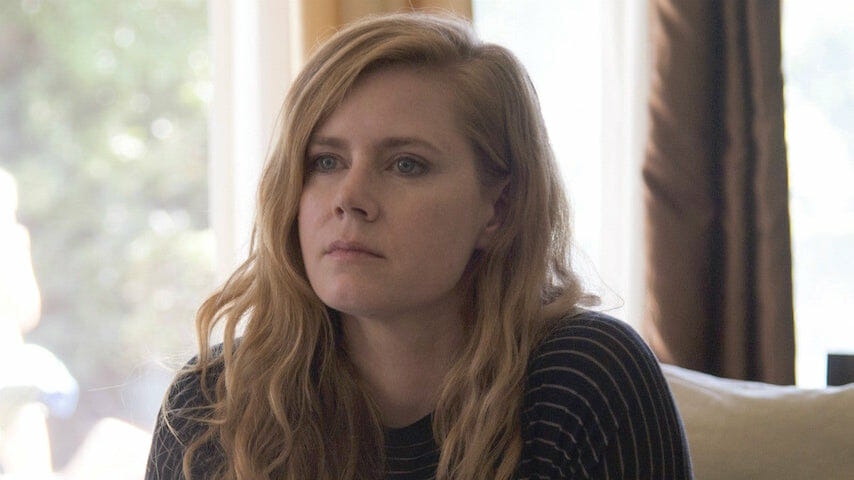Introducing Endless Mode: A New Games & Anime Site from Paste
Camille Preaker is a messy bitch and bad at her job.
While worthy of a page in the Burn Book, this largely was the critical reception of Amy Adams’s character for HBO’s Sharp Objects. The miniseries, which wrapped roughly two years ago in August, launched many angry responses
from predominantly female cultural critics, outraged by Camille’s less-than-desirable journalistic standards. These were easy marks. Should Camille stop drinking on the job, hooking up with multiple sources (including a barely-legal brother of a murder victim), carving her trauma into her skin, and taking inadequate notes during interviews? Absolutely. But the function of her character and the larger aim of the miniseries shouldn’t have to service the image female journalists want to see of themselves on-screen in order to be valid.
There’s an uneasy tension between characters that exist as “representation for representation’s sake” versus those who earn a fully fleshed out storyline. These two categories are not always mutually exclusive, but oftentimes characters that deviate from norm— anyone who isn’t a cishet, able-bodied, and neurotypical white man—slot into one or another. Conversations on tokenism abound as the laziest way from showrunners to fold in “diverse” casting while doing the least amount of work to incorporate minorities into the plot. With Camille Preaker, this rationale doesn’t quite jive with her character’s handling by screenwriters. She does occupy the main role of the show and exercises a large range of agency in her storyline. But critics didn’t like her because of her choices.
Camille barely operates as a problematic fave within the world of Sharp Objects’s Wind Gap. As a character, she struggles. There’s the vodka in an Evian bottle that supports her will to live day to day. She buys a sewing kit in order to possess a sharp object with which to cut herself; a writer who needs her scars as both a text to parse her story and armor to protect herself against the world. With that said, Camille’s earned the right to flounder. The layers of trauma Camille’s yoked with matches the density of her body modifications. Knowing this, why can’t viewers, especially women, let Camille bungle her job and sex life without the vitriol?
Issues with women’s representation often overlap with the similar ones for queerness on TV, and ire flows from both communities on how that representation is handled. The queer community has become rightfully defensive of its depictions in media. Before the massive shift in acceptance towards LGBTQIA people within the last half decade, writers baked queerness into films and TV through backdoor ways, the most infamous method being
queer-coding villains. While detractors may claim that at least queer people secured a foothold in media through one type of character, for others in the community the archetype was the problem. The oversaturation of villainy and gayness made both attributes seem irrevocably wed together. I suspect a similar wary tiredness was behind the raised hackles of female critics on the issue of Camille’s character: she continues a tradition of unprofessional female journalists in popular culture, further forging the link between sloppiness and women-led journalism.
Stepping back from the industry’s clear failings, the artistic mission to create realistic, full-bodied characters should remain the end goal for TV writing. Camille’s reality as a traumatized female journalist should remain a valid option as a character, even if the way she expresses her trauma is discomforting for critics and audiences alike. Beyond her identity as a woman, her trauma and its corresponding mental illnesses remain the central facet of her character. Amy Adams even labeled her experience playing Camille as a rare ”accurate telling of female trauma.” Gillian Flynn sought to write the novel, which became the miniseries, to generate conversations around ”the dark side of female psychology.” Even as female characters get shafted into minimizing roles—which deserve to be called out—I don’t think this is Sharp Objects’s issue. Instead, the series had the audacity to create a white woman character that severs any connection to the Victorian ideal of the ”Angel of the House.” Camille will not and cannot perform morality standards back to critics in her psychological condition—and we shouldn’t expect her to. It was never in Camille’s blueprint to fulfill this purpose.
While it is disconcerting to realize that white women audiences (and critics) have benefited from seeing themselves reflected as moral authorities in media, even as that trope ultimately is undermined by patriarchy, Camille should serve as a reminder that female characters should be liberated from being likeable, or even perfect. Who cares that she mixes substance use and work? This question never is asked of other male addicts: Jimmy McNulty’s shady police work, House’s horrible bedside manner, Don Draper’s alcoholic marketing, or Sherlock Holmes’s heroin-aided detective work. Instead of scrabbling around in the margins of women’s representation, let’s embrace Camille for being something scuffed, yet real. The body of her work and her body itself scream this: let’s read her for what she left behind for us to see.
Katherine Smith is an editorial intern and writer at Paste Magazine, and recent graduate of the University of Virginia. For a deeper dive into her current obsessions and hot takes follow her at @kat_marie_tea
For all the latest TV news, reviews, lists and features, follow @Paste_TV.
